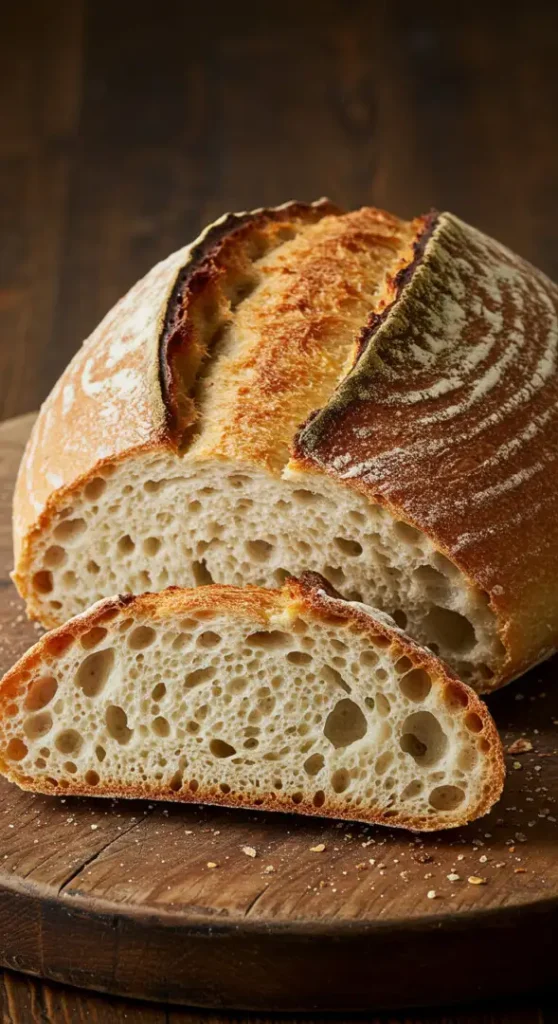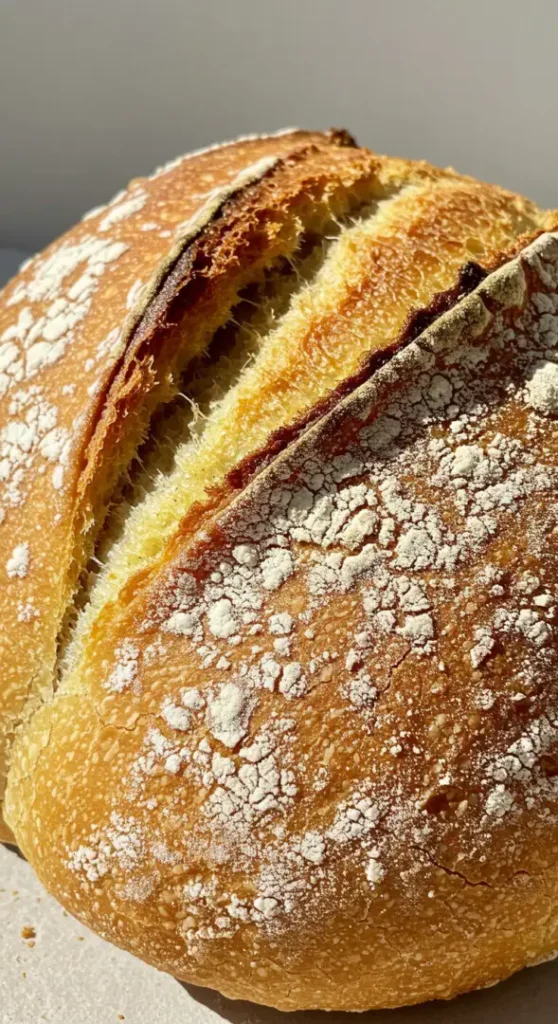Crusty Italian Bread
Crusty Italian bread is more than just a loaf—it’s a sensory experience. From its golden, crisp crust to its soft, airy crumb, this traditional Italian staple brings old-world flavors right to your kitchen. Below, we present a detailed, step-by-step guide to making authentic crusty Italian bread, ensuring bakery-level results every time.

What Makes Italian Bread Crusty and Irresistible?
The secret to achieving the perfect crust lies in hydration, fermentation, and baking technique. Italian bread recipes use simple ingredients—flour, water, salt, and yeast—but when treated correctly, they produce a texture and flavor that’s hard to match.
- High-hydration dough = open crumb structure
- Steam baking = glossy, crackly crust
- Slow fermentation = rich flavor depth
Essential Ingredients for Crusty Italian Bread
To make traditional Italian bread, keep the ingredient list simple and high-quality:
| Ingredient | Amount | Notes |
|---|---|---|
| Bread Flour | 4 cups (480g) | High-protein content ensures structure |
| Warm Water | 1½ cups (360ml) | Ideal temp: 100°F (38°C) |
| Active Dry Yeast | 2¼ teaspoons (1 packet) | Can substitute with instant yeast |
| Salt | 2 teaspoons | Enhances flavor |
| Sugar | 1 teaspoon | Feeds the yeast for better rise |
| Olive Oil (optional) | 2 tablespoons | Adds softness and aroma |
Step-by-Step Crusty Italian Bread Recipe

1. Activate the Yeast
In a large bowl, combine warm water, yeast, and sugar. Stir gently and let it sit for 5–10 minutes until it becomes frothy. If there’s no foam, the yeast may be dead.
2. Mix the Dough
Add flour and salt to the bowl. Mix with a wooden spoon or your hands until a shaggy dough forms. Add olive oil if using. Knead on a floured surface for 10 minutes, or use a stand mixer with a dough hook on medium speed for 6–7 minutes.
3. First Rise (Bulk Fermentation)
Place the dough in a greased bowl. Cover with a damp cloth and let it rise in a warm place for 1½ to 2 hours, or until doubled in size.
4. Shape the Dough
Punch down the dough to release gas. Gently shape it into a round boule or oval batard. Place on a parchment-lined baking sheet or in a proofing basket.
5. Second Rise
Cover loosely and let it rise again for 30–45 minutes. This final proofing is key to developing the loaf’s structure.
6. Prepare for Baking
Preheat your oven to 450°F (230°C) with a cast iron pan or baking stone inside. Place a metal tray at the bottom of the oven (for steam).
Just before baking, score the bread with a sharp knife or lame to allow controlled expansion.
7. Bake with Steam
Place the loaf on the hot stone or tray. Pour a cup of hot water into the bottom tray to create steam, then quickly close the oven door.
Bake for 25–30 minutes, until the crust is deep golden and it sounds hollow when tapped on the bottom.
Tips for Extra-Crusty Italian Bread
- Use a preheated Dutch oven to trap moisture and enhance oven spring.
- Spray the dough with water before baking for extra steam.
- Let the bread cool completely on a wire rack—this sets the crust and prevents sogginess.
Why Italian Bread Has That Signature Crust
The intense heat and added steam cause the outer layer of the dough to gelatinize rapidly, creating a blistered, chewy, and glossy crust. The inner crumb, meanwhile, remains soft and springy thanks to slow fermentation.
Crusty Italian Bread vs. French Baguette
| Feature | Italian Bread | French Baguette |
|---|---|---|
| Shape | Round or oval | Long and thin |
| Crust Texture | Chewy, blistered | Thin and crisp |
| Interior | Slightly denser | Airy and light |
| Ingredients | May include olive oil | Strictly water, flour, yeast, salt |
| Flavor Profile | More rustic and earthy | Milder with subtle tang |
Variations of Crusty Italian Bread
Pane Rustico
Rustic, country-style loaf with higher hydration and long fermentation. Deeply caramelized crust.
Pane di Altamura
Made from durum wheat semolina. Dense crumb and strong wheat flavor. Traditionally wood-fired.
Ciabatta
Known for its slipper shape and porous crumb. Requires high hydration and special folding techniques.
Storage Tips for Crusty Italian Bread
- Room temperature: Store in a paper bag or wrapped in a clean towel for 2–3 days.
- Freezing: Slice and wrap tightly in foil or freezer bags. Keeps for up to 3 months.
- To refresh: Sprinkle with water and reheat at 375°F (190°C) for 8–10 minutes.
Serving Suggestions
- Dipping: Serve with extra virgin olive oil and balsamic vinegar.
- Sandwiches: Slice thick for hearty paninis or cold cuts.
- Bruschetta base: Grill and top with tomatoes, basil, and garlic.
- Soup side: Perfect accompaniment to Italian soups like minestrone or ribollita.
Troubleshooting Common Issues
| Problem | Cause | Solution |
|---|---|---|
| Pale Crust | Oven not hot enough | Preheat thoroughly, use baking stone |
| Dense Interior | Underproofed or over-kneaded | Allow enough rise time, knead gently |
| Crust Too Hard | Overbaked or lack of moisture | Shorten bake time or increase steam |
| Dough Spreads Flat | Overproofed or weak flour | Use bread flour and monitor proof times |
Final Thoughts on Crusty Italian Bread
Mastering crusty Italian bread takes technique, time, and patience, but the reward is a loaf that rivals artisan bakeries. The combination of minimal ingredients and skilled methods is what sets this bread apart.







